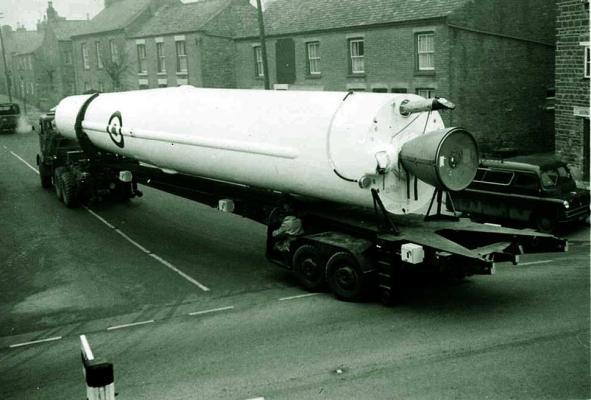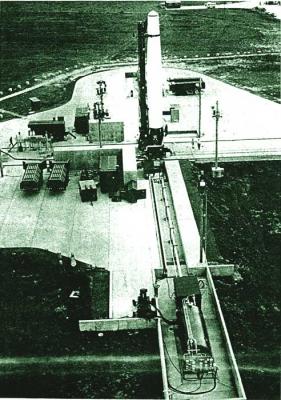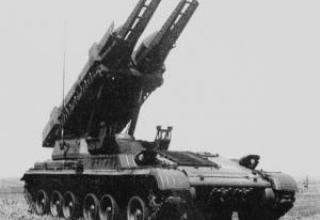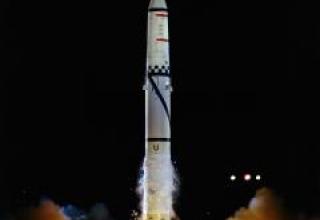In 1951, the Air Force's Wright Air Development Center, located at Wright Patterson Air Base (Ohio), concluded that the tactical cruise missile TM-61 "Matador", which was in service with the Air Force, has poor performance, given the prospects for the development of air defense of the USSR. The Center recommended the Air Force to develop and adopt a tactical-range ballistic missile, which at that time could not be intercepted technically. The Air Force's Tactical Air Command approved the concept, and soon the Air Force General Staff ordered the Air Force Research and Development Command to develop a detailed plan to build a new missile by June 1, 1955. By 1960, it was planned to start flight tests of the new missile.
Initially, the new missile development program was not considered a program of particular importance in the Air Force - the military focused more on improving the fleet of strategic bombers and the development of technology to build ICBMs. The situation with the development of a promising tactical missile for the Air Force radically changed in 1955 after the so-called Killian Committee to President D. Eisenhower. The report of the committee said that, along with the development of ICBMs, the U.S. should immediately begin developing MRBMs with a range of about 2,400 km. A new class of missiles was to be deployed both on land (on U.S. bases in Europe) and at sea (options were considered for basing new missiles on submarines as well as on special ships). The need to develop a new class of missiles was proved by references to intelligence, indicating that the USSR had already begun developing its own MRBMs. By the end of 1955, the Army, Air Force and Navy declared their fundamental readiness to start developing MRBMs. However, the beginning of concrete actions was hindered by uncertainty about which agency would be responsible for the development of new missiles. In November 1955, Minister of Defense Ch. Wilson announced that the Air Force would be responsible for the development of land-based MRBMs, and the joint Army / Navy team - for the development of sea-based MRBMs. In December 1955, President D. Eisenhower named the MRBM development program a top priority.
The ground-based missile developed by the Air Force was designated SM-75 "Thor" (the development of the missile was part of the WS-315A weapon system). In May 1955, the scientific and technical guidance for the program was transferred from the Air Force's Aircraft Development Center to the Western Development Division, California. In November of the same year, WDD began the final selection of the main contractor for the missile. Initially there were three candidates - Douglas Aircraft, Lockheed Aircraft, North American Aviation. After consideration of all proposals by the end of December 1955, the main contractor was named - the company "Douglas Aircraft" (the missile was designated DM-18).
When creating the new MRBM as widely as possible (especially when creating the power plant, control system, assembly of the BC / BC) was used unification with existing missile programs, primarily Atlas. North American Aviation's "Rocketdyne Division" was chosen as the main contractor for the power plant. The inertial control system was developed by General Motors' AC Spark Plug, and a duplicate/supplementary radio inertial control system allowing the missile to be controlled from a ground station (primarily during testing) was created by Bell Telephone Laboratories. The combat unit was created by General Electric Corporation, while the combat unit was traditionally developed by the Atomic Energy Commission.
Given the extreme rush caused by the Air Force's desire to overtake not only the USSR, but also the Army with its own MRBM "Jupiter", WDD classified the new program among the "maximum risk" programs. This prediction was confirmed - the first, second and third test launches in January, April and May 1957, respectively, from the Eastern Missile Range, Patrick Air Force Base, Florida, were unsuccessful. However, the work on troubleshooting with the participation of all involved in the program of scientific and technical personnel in the mode of "three shifts, 7 days a week" has borne fruit - in August, the first flight was held, recognized as "partially successful". On September 20, 1957 the first fully successful launch of "Thor" MRSD took place. Despite these successes, the Air Force had cause for concern - the Thor program had the strongest rival, the Jupiter program of MRBM, which had similar characteristics to Thor. However, the fears did not come true - on a wave of unjustified panic (carefully spurred by interested representatives of the U.S. military industry), caused by the launch of the Soviet First Earth Satellite, President D. Eisenhower in October 1957, gave the order to begin mass production of both U.S. MRBM.
In December 1957, the President of the United States made a fundamental decision to deploy MRSD "Thor" on the European continent (previously considered and such exotic options as the placement of MRSD "Thor" in the state of Alaska near Fairbanks). In February 1958, a joint U.S.-British agreement "on mutual understanding" for the deployment of 4 squadrons of MRBM "Thor" (60 MRBM) was concluded. The British achieved for themselves the right to provide independent maintenance of missiles, which were to carry the identification marks of the Royal Air Force. However, combat units were to remain at the disposal of the U.S. Air Force Strategic Air Command and docked to MRBM only with the permission of the U.S. side (later it was stipulated the right of each party to use weapons in regular equipment without the consent of the partner in case of "emergency" - the so-called "Project E"). The transportation and material service of the missiles should have been provided to the maximum extent possible by the United States. The final agreement was signed in June 1958. An agreement on technical cooperation between the U.S. Air Force and the Royal British Air Force as part of the Thor MRBM deployment and further maintenance programme was signed in July. The programme to deploy new MRBMs in the UK was named "Project Emily". To monitor and support the deployment of a new weapons system, the U.S. Air Force SAC activated the 705th Strategic Missile Wing at Lakenheath Air Force Base, UK, in February 1958. The equipment and systems to be deployed began to move to the United Kingdom in August 1958. The first MRBM was handed over to the Royal Air Force in September of that year.
In June 1958, the first successful launch of the prototype BRSD "Thor" from the prototype of the standard launch unit was carried out from the airbase Patrick. The first successful launch of the system in standard equipment was carried out in November 1958 in the same place. Since December 1958, the launches were also carried out from the Western Missile Range, Vandenberg Air Base, California. The first launch of MRSD "Thor" by British personnel was made from the air base Vandenberg in April 1959 (operation "Lion's Roar"). In June of the same year, the first MRBM "Thor" base in the British Isles - airbase Feltuell, where the 77th strategic missile squadron of the Royal Air Force was located, was recognized suitable for further combat duty. In September 1959, the second base of MRBM "Thor" in the British Isles - Hemswell Air Base, where the 97th Strategic Missile Squadron of the Royal Air Force was located, was recognized as suitable for combat duty. In October, from the air base Vandenberg British personnel successfully completed the first launch of MRBM "Thor" on the combat training program (until June 1962, such launches were made 12). In November, the third base of MRBM "Thor" in the UK - Driffield, where the 98th strategic missile squadron of the Royal Air Force was placed. In December 1959, the U.S. and Britain signed a joint protocol, which confirmed that the deployed by then on British territory MRBM "satisfactorily demonstrated operational readiness. In April 1960, the deployment of MRBM "Thor" in the UK was completed with the commissioning of the fourth missile base - North Laffenham, where the 144th strategic missile squadron of the Royal Air Force. The first staff thermonuclear BC was docked to the MRBM for duty in June 1960 at the airbase Feltuell. In 1962, after changing the designation system in the U.S. Air Force, the Thor missile was designated PGM-17A.
By spring 1962, the SAC Air Force had successfully deployed first-generation ICBMs (Atlas and Titan I), deployed second-generation systems (Minuteman I and Titan II), and successfully deployed nuclear-powered submarines with Polaris SLBMs on board. Given these factors, it became clear that land-based MRBMs were too vulnerable, especially Thor, whose EO were stationary. Therefore, as early as May 1962, U.S. Defense Secretary R. McNamara notified his British counterpart P. Tornickroft that after October 31, 1964 the U.S. ceased transport support of MRBMs deployed in Britain. In this regard, after analyzing the situation in August of the same year, P. Tornickroft notified the British Parliament about the forthcoming deactivation of BRSD "Thor" by December 31, 1963. However, despite the planned deactivation of MRBM data, the presence of a significant number of American missiles of the same class in Italy and Turkey, coupled with a clear American superiority in the number of strategic bombers and ICBMs forced the Soviet leadership to take similar measures. By October 1962, Soviet MRBMs were deployed in Cuba, taking a significant portion of the continental United States targets. The so-called "Caribbean crisis" that broke out in October 1962 allowed the Soviet Union to raise the issue of deactivation of American MRBMs in Europe in exchange for the withdrawal of Soviet missiles from Cuba. An agreement was reached between the parties. The first MRBM "Thor" was taken off combat duty in late November 1962. The last MRBM on British territory was off duty in August 1963, and at the end of September it was sent to the USA by air. The final deactivation of MRBM "Thor" as a weapon system was completed in December 1963.
Evaluating the program "Thor", it can be noted that in a relatively short period of time the Americans managed to create a fairly reliable MRBM, which provided a confident by the standards of the early 60's defeat of the main military and political targets in the USSR and the IAB. Unlike its rival, the Jupiter MRBM, the Thor missile was very actively used as a carrier rocket with various additional stages and later became the ancestor of the Delta LV family.
The Thor missile (a modification of the Thor DSV-2J) was the basis for one of the first U.S. space defense systems "Program 437" (see photo), which went on combat duty in August 1964 on the island of Johnston (Pacific Ocean). The system was on combat duty until 1975, although its expected effectiveness was low.
In total, 224 "Thor" missiles of various modifications were built.
Composition:
The Thor rocket was designed according to the scheme with the tank supporting structure and was structurally divided into several parts (see diagram).
The power pack compartment bearing the MB-1 designation contained a liquid-propellant LR-79-NA-9 rocket engine and controls. Two auxiliary (vernier) liquid-propellant LR-101-NA-7 rocket engines were attached to the rear bulkhead of the compartment, which controlled the missile in the boost phase through a roll channel and were also used to adjust the missile speed after cutting off the marching engine. The missile was controlled through the pitch and yaw channels by deflecting the marching engine in the cardan suspension by up to 5°. All engines used a turbo-pump system to supply fuel without afterburning the gas generator. At the bottom of the engine compartment 4 stabilizers were attached to the body. The engine compartment was attached to the oxidizer tank (liquid oxygen), which, in turn, was connected to the central part of the rocket (the inter-tank compartment), where auxiliary equipment was placed, including the self-liquidation system of the rocket. This was followed by a tank with fuel (rocket kerosene RP-1) and a compartment with guidance and control system.
The Mk2 combat unit, which contained a thermonuclear warfare unit W-49, was connected to the guidance and control system compartment. The missile casing was made of high-strength aluminum alloy. Sections of fuel tank compartments were assembled from panels with a waffle-type power pack, obtained by stamping, followed by chemical milling. The missile's combat unit was a truncated cone with a pointed nose. At the base of the BC was the control and stabilization equipment of the BC after separation from the marching stage. The BMD was separated from the missile body after the vernacular engines had finished their work. Withdrawal of the ballistic missile from the ballistic missile booster stage was carried out with the help of low-power solid propellant engines located in the inter-bank compartment. Thermal-protective coating of the booster was carried out according to the scheme of absorption of thermal flows (further the variant of equipping the booster with a new Mk3 booster with ablative heat-protective coating was considered).
MRBM "Thor" were placed in the starting position (see diagram), made of reinforced concrete with a high percentage of reinforcement with dimensions 76.2 * 15.2 m, in a horizontal position on a special device with hydraulic lifts. The device with unfilled fuel components of MRSD was covered by a 30.5 m long light roof that was rolled back on rails. After receiving a launch order, the starting calculation rolled back the roof and brought the rocket with the help of lifts to a vertical position. After the rocket was installed, the process of high-speed refueling of the rocket with propellant components began, after which the rocket was considered ready for launch and all systems were checked. The entire procedure to prepare the missile for launch took no more than 15 minutes. After receiving the signal that the system was fully ready, the officer on duty initiated the launch. First, the marching engine was activated. The Vernier engines started after 2.5 seconds. The marshal engine had a running time of 157 seconds. After cutting off the thrust of the marching engine, the vernier engines made a precise correction of the rocket speed within 9 seconds. Then they were shut down and the pyrobolts that connected the HC with the marching stage body were triggered. Finally, the control system signal triggered the solid propellant withdrawal engines. The flight time for the maximum range was about 18 minutes.
Each strategic missile squadron, which had in its arsenal "Thor" BRS, had on duty 15 missiles, distributed on 5 starting positions (3 BRS on each position). The launcher of each missile was located at a distance of 180-280 meters from the adjacent PA. Tanks with fuel components were placed in special concrete depressions. Various auxiliary mechanisms (diesel generators, etc.) were covered with concrete lining. The method of placing the MRBM "Thor" provided very limited resistance to PFU.
Characteristics:
| Range of fire, km | 2400 |
| Trajectory apogee height, km | 480 |
| KVO, km | 1 |
| BC power, Mt. | 1.44 |
| Length assembled, m | 19.82 |
| Diameter of the case maximum, m | 2.44 |
| Diameter on stabilizers, m | 2.74 |
| Weight in gear, t. | 49.8 |
| Weight of combat equipment, t | 1 |
| It's a marshal engine: - thrust at sea level, kN - vacuum thrust, kN - specific impulse at sea level, s - specific pulse in a vacuum, s |
670 760 248 282 |
| Vernier motor (2 pcs): - thrust each at sea level, kN |
4.5 |
Testing:
Testing of the complex began on April 21, 1995 at White Sands Range and continued with varying success until 1999. Only the ninth launch, on March 29, 1999, demonstrated the performance of the complex as a whole. During this flight, despite the failure of the interceptor's spatial orientation system for 23 seconds of flight and the termination of telemetry data reception for 58 seconds, the interceptor passed in close proximity to the Hera target missile.
During the tenth test launch on June 10, 1999, for the first time, a target simulating a SKAD missile was successfully intercepted and the technical feasibility of such an intercept was confirmed.
On 2 August 1999, during the eleventh test, a target simulating a detachable SCAD-type ballistic missile head in the upper atmosphere was intercepted.
Sources:
- To defend and deter: the legacy of the United States cold war missile program / by J.C. Lonnquest and D.F. Winkler. USACERL, Champaign, IL, 1997.
- From Snark To Peacekeeper: A Pictorial History of SAC Missiles / by Office of the Historian HQ SAC. OH HQ SAC, Offut AFB, NE, 1990.
- SAC Missile Chronology 1939-1988 / by Office of the Historian HQ SAC. OH HQ SAC, Offut AFB, NE, 1990.
- Alert Operations and the SAC 1957-1991 / by Office of the Historian HQ SAC. OH HQ SAC, Offut AFB, NE, 1990.
- SAC and the Alert Program: A Brief History / by Office of the Historian HQ SAC. OH HQ SAC, Offut AFB, NE, 1988.
- The Development of Ballistic Missiles in the United States Air Force / J. Neufeld. Office of AF history, USAF, DC, 1990
- US Strategic and Defensive missile systems 1950-2004 / M.A. Berhow and C. Taylor. Osprey Publishing Ltd., 2005.
- Широкорад А.Б. «Атомный таран XX века», 2005 Москва, «Вече».
- А.А. Шумилин «Авиационно-космические системы США», 2005 Москва, «Вече».
- www.nationalmuseum.af.mil






